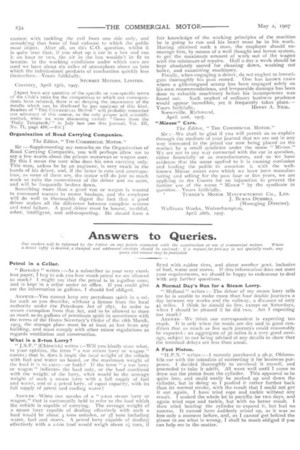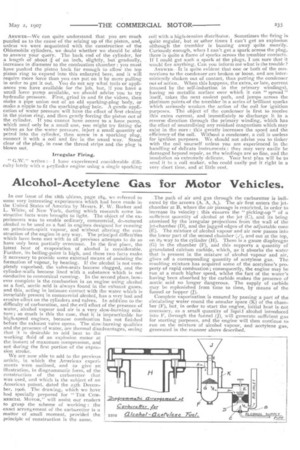Answers to Queries.
Page 22

Page 23

If you've noticed an error in this article please click here to report it so we can fix it.
Our readers will be informed by the Editor on any points connected with the consirFtction or use of commercial motors. Where
a direct reply is den red, a stamped and addressed ermelope should be enclosed : if a revuesUor privaCy is not specially made, any query and answer may be published.
Petrol in a Cellar.
" Barnsley " writes :—As a subscriber to your very excellent paper, I beg to ask you how much petrol we are allowed to stock? I might say that the petrol is in 2-gallon cans, and is kept in a cellar under an office. If you could give me the information in gallons, I should feel obliged.
ANSWER—You cannot keep any petroleum spirit in a cellar such as you describe, without a license from the local authority under thePetroleum Act of 1871. ln order to secure exemption from that Act, and to be allowed to store as much as 6o gallons of petroleum spirit in accordance with the terms of the Home Secretary's Order of the r8th March, 1903, the storage place must be at least 21:1 feet from any building, and roust comply with other minor regulations as regards ventilation and construction.
What is a 2-ton Lorry?
" J.S.F." (Chiswick) writes you kindly state what, in your opinion, the term " 2 ton steam lorry or wagon " covers; that is, does it imply the total weight of the vehicle with fuel and water on board, or the maximum weight of the load it is to carry—or both? If the term " 2 ton lorry or wagon " indicates the load only, or the load combined with the weight of the lorry, what would be the average weight of such a steam lorry with a full supply of fuel and water, and of a petrol lorry, of equal capacity, with its full supply of petrol and cooling water?
ANSWER—When one speaks of a " 2-ton steam lorry or wagon," that is customarily held to refer to the load which the vehicle is capable of carrying. The average weight of a steam lorry capable of dealing effectively with such a load would be about 3 tons unladen, or 3:1tons including water, fuel and stores. A petrol lorry capable of dealing effectively with a 2-ton load would weigh about 2:1 tons, if
fitted with rubber tires, and about another 3cwt. inclusive of fuel, water and stores. If this information does not meet your requirements, we should he happy to endeavour to deal with any further questions.
A Normal Day's Run for a Steam Lorry.
" Midland " writes :—The driver of my steam lorry tells me he is unable to make more than four double journeys a day between my works and the railway, a distance of only miles. I think he should do five, except.on Saturdays, when I should be pleased if he did two. Am. I expecting too much?
ANswER—We think our correspondent is expecting too much. It is only when the roads are dry and in good condition that as much as five such journeys could reasonably be expected : an aggregate of 36 miles is a very good average, subject to our being advised of any details to show that the terminal delays are less than usual.
A Fast piston.
"II.P.N." writes :—I recently purchased a 0h.p. Oldsmobile car with the intention of converting it for business -purposes. I decided thoroughly to overhaul it myself, and proceeded to take it adrift. All went well until I came to draw out the piston from the cylinder. This appeared to be quite free, and could easily be pushed. up and down the cylinder, but in doing so I pushed it rather further back than its normal stroke, with the, result that I could not get it out again. I have tried rope and tackle without any result. I soakedthe whole lot in paraffin for two days, and again tried rope and tackle, but with no better result. I then tried heating the cylinder to expand it, but had no success. It cannot have -suddenly seized up, as it was so free only a moment before, and, as I cannot get behind the piston to see what is wrong, I shall be much obliged if you can -help me in the matter.
ANSWER—We can quite understand that you are much puzzled as to the cause of the seizing up of the piston, and unless we were acquainted with the construction of the Oldsmobile cylinders, we doubt whether we should he able to answer your query. The back end of the cylinder, for a length of about of an inch, slightly, but gradually, increases in diameter to the combustion chamber : you must have pushed the piston back far enough to allow the top piston ring to expand into this enlarged bore, and it will require more force than you can put on it by mere pulling in order to get it out. You do not say what tools or appliances you have available for the job, but, if you have a small force pump available, we should advise you to try hydraulic pressure. First, grind in and fit the valves, then make a pipe union out of an old sparking-plug body, or make a nipple to fit the sparking-plug hole. A gentle application of water pressure will have the effect of first closing in the piston ring, and then gently forcing the piston out of the cylinder. If you cannot have access to a force pump, which need only be a small one, you might try fitting the valves as for the water pressure, inject a small quantity of petrol into the cylinder, then screw in a sparking plug, connect it with a coil and fire in the usual way. Stand clear of the plug, in case the thread strips and the plug is blown out.
Irregular Firing.
" G.W." writes :I have experienced considerable difficulty lately with a 4-cylinder engine using a single sparking coil with a high-tension distributor. Sometimes the firing is quite regular, but at other times I can't get an explosion although the trembler is buzzing away quite merrily. Curiously enough, when I can't get a spark across the plug, there is quite a flame of sparks across the trembler contacts. If I could get such a spark at the plugs, I am sure that it would fire anything. Can you inform me what is the trouble? ANSWER.It is quite evident that one or both of the connections to the condenser are broken or loose, and are intermittently shaken out of contact, thus putting the condenser Out of action. When this happens, the extra, or late, current (caused by the self-induction in the primary windings), having no metallic surface over which it can "spread " itself, takes the next easiest path, and jumps across the platinum points of the trembler in a series of brilliant sparks which seriously weaken the action of the coil for ignition purposes. The object of the condenser is first to receive this extra current, and immediately to discharge it in a reverse direction through the primary winding, which has the effect of neutralising any residual magnetism which may exist in the core : this greatly increases the speed and the efficiency of the coil. Without a condenser, a coil is useless for ignition purposes. We should not advise you to tinker with the coil yourself unless you are experienced in the handling of delicate instruments : they may very easily be damaged beyond repair, as the windings are so fine, and the insulation so extremely delicate. Your best plan will be to send it to a coil maker, who could easily put it right in a very short time, and at little cost.


























